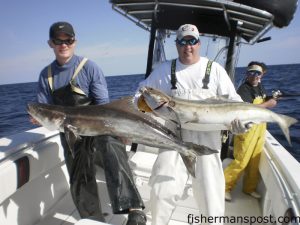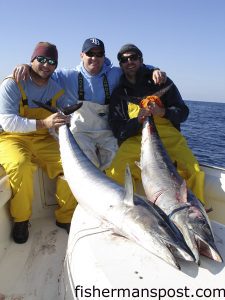Wrightsville Beach March 10, 2011

Rob Schneider and Chris Branco with 40 and 48 lb. cobia they hooked while deep-jigging in 240' of water just north of the Same Ole Hole. They were fishing with Capt. Mike Jackson of Live Line Charters out of Wrightsville Beach.
Tex, of Tex’s Tackle, reports that anglers are hooking up with some red and black drum in the backs of the creeks off the ICW. Scented soft baits like Gulps are top producers in the early season, and anglers can also hook up using cut shrimp on bottom rigs.
As the surf water temperature climbs a few degrees, anglers will start seeing sea mullet and other bottom feeders in the surf zone, where they’ll also take an interest in shrimp on bottom rigs.
Anglers are reporting small bluefish around the wrecks and reefs 5+ miles off Masonboro, and those fish should be making their way to the inlets very soon. They’ll take an interest in metal jigs, soft plastics, hard baits, and just about anything else anglers can cast.
Offshore, boats are reporting schooling king mackerel in the 50 mile range, and those fish will begin making their way towards the coast as warmer water pushes inshore over the next month. Dead cigar minnows and Drone spoons or other artificials are top choices for the early season kings when anglers can find them.
The weather has prevented anglers from taking too many blue water trips thus far this year, but when they’ve made the run to blue water, they’ve been rewarded with excellent catches of blackfin tuna and plentiful amberjacks. Jigging is producing most of the action with the blackfins and jacks.
Some wahoo should be feeding along the break as well, and anglers can target them with trolled ballyhoo and skirted lures.

Jarrett Shearin, Hamp Stephens, and Kemp Burdette with 62 and 67 lb. wahoo they hooked on skirted ballyhoo while trolling the Gulf Stream near the 150 line with Capt. Clint Richardson. Weighed in at Bridgetender Marina.
Frank, of Intracoastal Angler, reports that the inshore red drum bite has been excellent for this time of year. Anglers are finding the reds in the creeks, around ICW docks and in the marshes, and in the backwaters off the lower Cape Fear. Gulp baits are top choices for the drum this time of year.
Anglers are also picking up some speckled trout in many of the same areas as the reds, but they can’t keep any until the season re-opens in June.
The catch-and-release striped bass fishing is still excellent in the Cape Fear River, where anglers are hooking up while casting soft plastics to creekmouths, drop-offs, and other structure, and also by trolling diving lures along channel edges.
Not much has been reported on king mackerel this winter, but boats are seeing some false albacore and spanish mackerel around 35 miles offshore, and the fish will be moving closer to the beaches as the water warms over the coming weeks.
Offshore, anglers have found some excellent action while jigging the drop-offs and structure on the edge of the break. Amberjacks, blackfin tuna, cobia, African pompano, and more are falling for the vertical jigs, and the bite should stay solid over the next month.
Trollers are finding some action with wahoo along temperature breaks in the same area, where they’re biting skirted ballyhoo and trolling lures.
Rick, of Living Waters Guide Service, reports that Gulf Stream jigging has been quite productive when the winds let anglers make it out to the break. Anglers are connecting with amberjacks, African pompano, cobia, and a variety of bottomfish on vertical jigs around structure in 150-250’ of water. Blackfin tuna (most 20-30+ lbs.) are feeding slightly deeper, and they are also readily attacking the jigs.

Kenny Klutz with a striped bass he hooked while trolling diving plugs in 15' of water in the Cape Fear River while fishing with Tim Boyle. The striper was released just after the photograph.
Jim, of Plan 9 Charters, reports that the red drum bite inshore is still solid, and anglers are finding action with the reds in the creeks and on the flats throughout the area. Gulp baits and natural baits are top choices for the reds in the cooler water of early spring.
Tautog, sheepshead, and other bottom feeders are holding around structure within 10 miles off the beaches. Shrimp, crab chunks, and other crustacean baits will tempt them to bite.
Rob, of Johnnie Mercer’s Pier, reports that anglers are catching plenty of dogfish. A few sea mullet have also come over the rails in the past weeks, and one speckled trout was landed last week.
The water temperature is 54 degrees, and once it climbs into the high-50’s, anglers should see much improved action for sea mullet and other early season bottom feeders.
